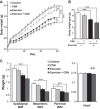A combination of exercise and capsinoid supplementation additively suppresses diet-induced obesity by increasing energy expenditure in mice
- PMID: 25516550
- PMCID: PMC5504431
- DOI: 10.1152/ajpendo.00354.2014
A combination of exercise and capsinoid supplementation additively suppresses diet-induced obesity by increasing energy expenditure in mice
Abstract
Exercise effectively prevents the development of obesity and obesity-related diseases such as type 2 diabetes. Capsinoids (CSNs) are capsaicin analogs found in a nonpungent pepper that increase whole body energy expenditure. Although both exercise and CSNs have antiobesity functions, the effectiveness of exercise with CSN supplementation has not yet been investigated. Here, we examined whether the beneficial effects of exercise could be further enhanced by CSN supplementation in mice. Mice were randomly assigned to four groups: 1) high-fat diet (HFD, Control), 2) HFD containing 0.3% CSNs, 3) HFD with voluntary running wheel exercise (Exercise), and 4) HFD containing 0.3% CSNs with voluntary running wheel exercise (Exercise + CSN). After 8 wk of ingestion, blood and tissues were collected and analyzed. Although CSNs significantly suppressed body weight gain under the HFD, CSN supplementation with exercise additively decreased body weight gain and fat accumulation and increased whole body energy expenditure compared with exercise alone. Exercise together with CSN supplementation robustly improved metabolic profiles, including the plasma cholesterol level. Furthermore, this combination significantly prevented diet-induced liver steatosis and decreased the size of adipocyte cells in white adipose tissue. Exercise and CSNs significantly increased cAMP levels and PKA activity in brown adipose tissue (BAT), indicating an increase of lipolysis. Moreover, they significantly activated both the oxidative phosphorylation gene program and fatty acid oxidation in skeletal muscle. These results indicate that CSNs efficiently promote the antiobesity effect of exercise, in part by increasing energy expenditure via the activation of fat oxidation in skeletal muscle and lipolysis in BAT.
Keywords: capsinoids; energy expenditure; exercise; fat oxidation; obesity.
Copyright © 2015 the American Physiological Society.
Figures






References
-
- Anthonsen MW, Ronnstrand L, Wernstedt C, Degerman E, Holm C. Identification of novel phosphorylation sites in hormone-sensitive lipase that are phosphorylated in response to isoproterenol and govern activation properties in vitro. J Biol Chem 273: 215–221, 1998. - PubMed
-
- Baar K, Wende AR, Jones TE, Marison M, Nolte LA, Chen M, Kelly DP, Holloszy JO. Adaptations of skeletal muscle to exercise: rapid increase in the transcriptional coactivator PGC-1. FASEB J 16: 1879–1886, 2002. - PubMed
-
- Baraldi PG, Preti D, Materazzi S, Geppetti P. Transient receptor potential ankyrin 1 (TRPA1) channel as emerging target for novel analgesics and anti-inflammatory agents. J Med Chem 53: 5085–5107, 2010. - PubMed
-
- Batsis JA, Nieto-Martinez RE, Lopez-Jimenez F. Metabolic syndrome: from global epidemiology to individualized medicine. Clin Pharmacol Ther 82: 509–524, 2007. - PubMed
-
- Bostrom P, Wu J, Jedrychowski MP, Korde A, Ye L, Lo JC, Rasbach KA, Bostrom EA, Choi JH, Long JZ, Kajimura S, Zingaretti MC, Vind BF, Tu H, Cinti S, Hojlund K, Gygi SP, Spiegelman BM. A PGC1-alpha-dependent myokine that drives brown-fat-like development of white fat and thermogenesis. Nature 481: 463–468, 2012. - PMC - PubMed
Publication types
MeSH terms
Substances
Grants and funding
LinkOut - more resources
Full Text Sources
Other Literature Sources
Medical

